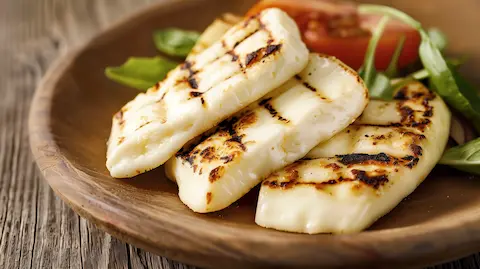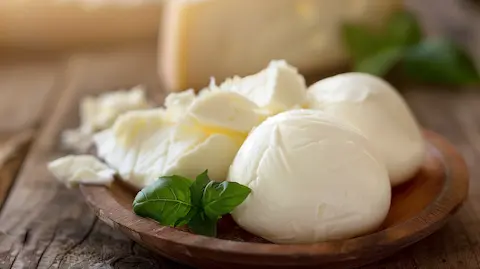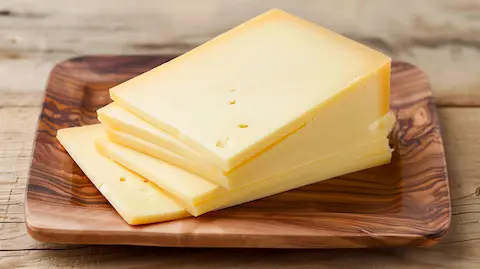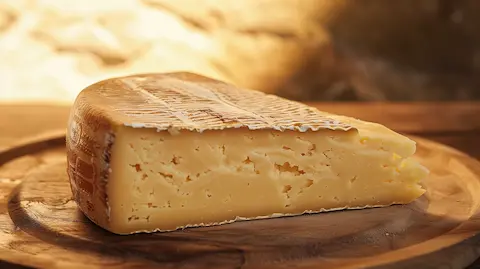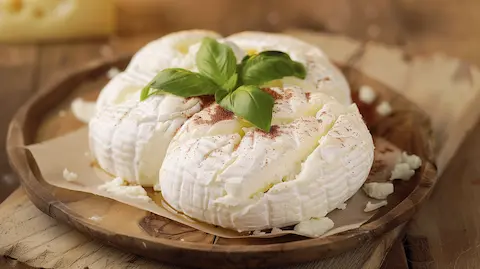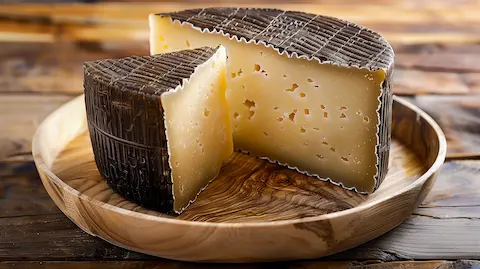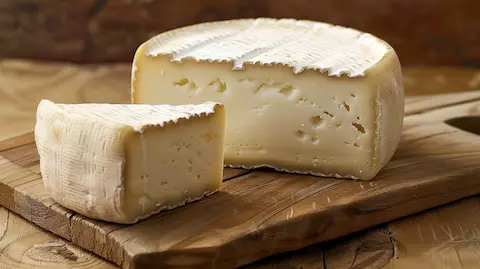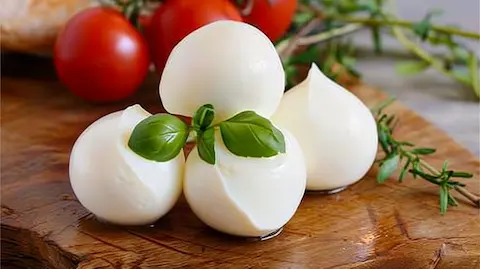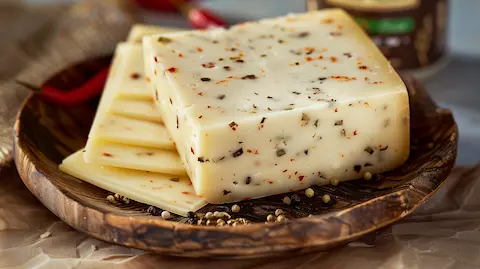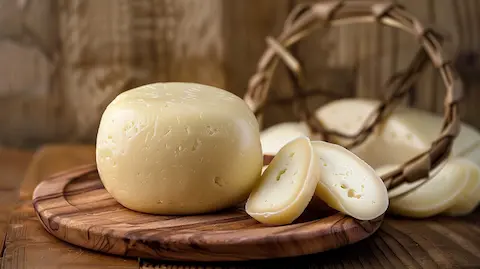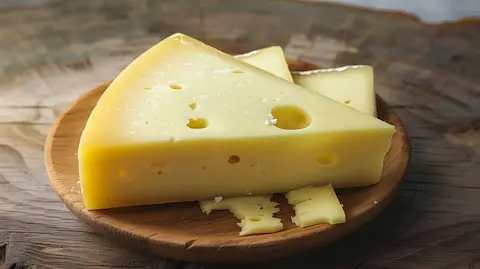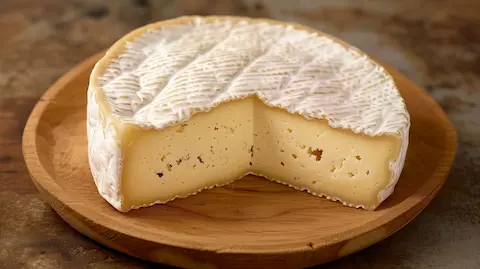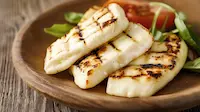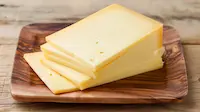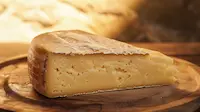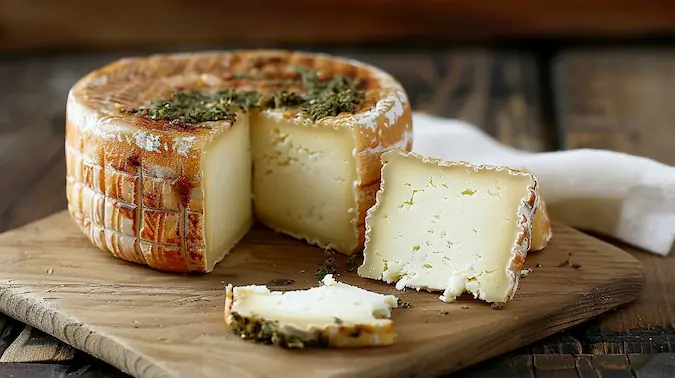Cana de Cabra cheese
Cana de Cabra is a soft-ripened cheese with a smooth, creamy texture and a gentle, tangy flavor that grows bolder with age. Originating from Spain, this goat's milk cheese is often compared to the French Chevre, yet it stands out with its own distinct character. Cana de Cabra is crafted using traditional methods, where the milk is gently pasteurized and set into molds to form its characteristic log shape. As it ages, the cheese develops a thin, edible rind that encases the lush, ivory paste within.
Whether enjoyed fresh or allowed to mature, Cana de Cabra offers a versatile flavor profile that complements a variety of dishes and pairings. As a staple in Spanish cuisine, its presence on a cheeseboard elevates the overall experience, inviting cheese aficionados to explore its subtleties and nuances. With a history steeped in the cheese-making traditions of Spain, Cana de Cabra continues to be a cherished selection among those who appreciate its delicate balance of taste and texture.
How is Cana de Cabra made?
Cana de Cabra cheese is made by starting with the highest quality pasteurized goat's milk. This milk is then gently warmed and combined with select cultures and rennet, which coagulate the milk into curds. The curds are carefully cut and allowed to drain in molds that give Cana de Cabra its distinctive cylindrical shape. After unmolding, the young cheese is salted and left to age. During aging, a bloomy rind develops, and the cheese is periodically turned to ensure even ripening. This process allows for the development of its creamy texture and nuanced flavor.
Explore the meticulous steps involved in the creation of Cana de Cabra:
Cana de Cabra Cheese Production Process
| Step | Description | Ingredients | Temperature | Duration |
|---|---|---|---|---|
| 1. Pasteurization | Milk is heated to eliminate harmful microbes. | Goat's milk | 68-72°C (154-161°F) | 15-20 seconds |
| 2. Inoculation | Cultures are added to milk to start fermentation. | Starter cultures | 20-22°C (68-72°F) | 1 hour |
| 3. Coagulation | Rennet is introduced to form curds. | Rennet | 22-24°C (72-75°F) | 1-2 hours |
| 4. Draining | Curds are transferred to molds and whey is drained. | Room temperature | 6-12 hours | |
| 5. Salting | Cheese is salted to enhance flavor and preservation. | Salt | Room temperature | 1-2 hours |
| 6. Aging | Cheese is aged and rind is developed. | 10-15°C (50-59°F) | 7-30 days |
What does Cana de Cabra taste like
Cana de Cabra tastes like a harmonious blend of mild tanginess and earthy notes, with a buttery finish that grows more pronounced as the cheese matures. Its smooth, creamy texture complements the subtle hints of grass and herbs, reflecting the diet of the goats whose milk is used to craft this cheese. The aging process deepens the flavor profile, adding complexity and a slight piquancy that cheese lovers savor.
Cana de Cabra cheese profile
To fully appreciate Cana de Cabra, one must become familiar with its defining characteristics. This profile provides a concise overview of the cheese's attributes:
- Made from: Pasteurized goat's milk
- Country of origin: Spain
- Region: Typically produced in the central and southern regions
- Family: Soft-ripened
- Type: Soft, creamy
- Texture: Smooth and creamy with a soft rind
- Rind: Bloomy, edible
- Colour: White to ivory
- Flavour: Mild tanginess with earthy undertones
- Aroma: Goaty, with a hint of mushrooms due to the rind
- Vegetarian: Not typically, as it is made with animal rennet
- Producers: Various artisanal cheesemakers in Spain
How to store Cana de Cabra?
Proper storage of Cana de Cabra is key to preserving its delicate flavor and creamy texture. In the refrigerator, wrap the cheese in wax or parchment paper, which allows the cheese to breathe and maintains the desired humidity level. Then, place it inside a loose-fitting plastic bag or a container with a partially open lid to prevent it from absorbing other flavors and odors in the fridge.
- Initial Wrapping: Wrap the cheese in wax or parchment paper.
- Secondary Layer: Place the wrapped cheese in a loose plastic bag or container.
- Refrigeration: Keep in the main body of the refrigerator, not the door, to ensure a consistent temperature.
- Inspection: Check the cheese regularly for any signs of spoilage or mold.
- Consumption: Enjoy the cheese within its optimal freshness period for the best taste experience.
How long does Cana de Cabra cheese last?
When stored correctly, Cana de Cabra can maintain its quality for a considerable time. In the refrigerator, it typically lasts for up to two weeks, while the freezer can extend its shelf life, though freezing may affect its texture and flavor. Upon thawing, the cheese may become slightly crumblier and lose some of its buttery essence, but it remains suitable for cooking or baking.
| Storage Location | Shelf Life | Texture After Thawing | Taste After Thawing |
|---|---|---|---|
| Outside | 2 hours | ||
| Fridge | Up to 2 weeks | ||
| Freezer | 2-3 months | Slightly crumblier | Mild flavor loss |
Is Cana de Cabra cheese pasteurized?
Yes, cana de cabra is made from pasteurized goat's milk. This process ensures the safety and consistency of the cheese while preserving its delicate flavors and creamy texture that are characteristic of this Spanish delicacy.
Can you freeze Cana de Cabra?
Yes, you can freeze Cana de Cabra cheese. This method can help extend its shelf life for those who may not consume it immediately. However, freezing may change the cheese's texture, making it somewhat crumbly and less creamy upon thawing. While the flavor remains mostly intact, the altered texture is best suited for cooked dishes where the cheese will be melted or blended.
Alternatives to Cana de Cabra cheese
When Cana de Cabra is not available, or you're seeking a different taste experience, there are several cheeses that can serve as suitable replacements. Each alternative brings its own unique flavor and texture that can mimic or complement the characteristics of Cana de Cabra. The table below details these alternatives, highlighting why they might be a good substitute in terms of flavor, texture, and culinary uses.
Cana de Cabra cheese substitutes
| Cheese | Origin | Milk Source | Texture | Flavor | Aging Time | Best Used In |
|---|---|---|---|---|---|---|
| Bucheron | France | Goat | Semi-soft | Tangy with a creamy edge | 5-10 weeks | Salads, spreads, cheese boards |
| Chèvre | France | Goat | Soft to semi-firm | Mild to tangy | Fresh to 2 months | Dips, salads, sandwiches |
| Montrachet | France | Goat | Soft | Earthy and tangy | 2-4 weeks | Spreads, cheese plates |
| Feta | Greece | Sheep or a mix with goat | Crumbly | Salty, tangy | 2-3 months | Salads, baked dishes |
| Garrotxa | Spain | Goat | Firm | Nutty, milky | 2-4 months | Grating, cheese boards |
Cana de Cabra popular comparison
Among the cheeses commonly compared to Cana de Cabra, French Chèvre is perhaps the most notable. Chèvre, which simply means "goat" in French, refers to a variety of goat cheeses from France. While similar in milk source and general flavor profile, Chèvre can range from fresh to aged, offering a spectrum of textures and tastes that can either be milder or more pronounced than Cana de Cabra.
Cana de Cabra vs. Chèvre
| Cheese | Origin | Milk Source | Texture | Flavor | Aging Time | Uses |
|---|---|---|---|---|---|---|
| Cana de Cabra | Spain | Goat | Soft, creamy | Mild tanginess with earthy undertones | 7-30 days | Cheese boards, cooking, baking |
| Chèvre (French Goat Cheese) | France | Goat | Varies from soft to semi-firm | Mild to strong tanginess | Fresh to several months | Spreads, salads, cooking |
How to use Cana de Cabra
Cana de Cabra’s creamy and tangy profile makes it a versatile addition to many culinary creations. For optimal enjoyment, slice the cheese into rounds from the log, which can then be served as is or incorporated into dishes. Its creamy texture allows it to spread easily on crackers or bread, making it an ideal choice for appetizers. When heated, Cana de Cabra becomes delightfully smooth, perfect for drizzling over vegetables or folding into omelets. Its subtle flavor also enhances the taste of salads and pasta dishes without overwhelming the palate.
- Slicing: Cut into rounds or spread on crackers and bread.
- Heating: Melt over dishes for a smooth texture.
- Appetizers: Serve as a starter with figs or nuts.
- Salads: Crumble into greens for a creamy bite.
- Pasta: Incorporate into sauces or top dishes for added flavor.
- Baking: Include in savory tarts or quiches.
How to serve Cana de Cabra cheese
Present Cana de Cabra at room temperature to allow its full range of flavors to emerge. On a cheese board, pair with sweet accompaniments like honey or fruit preserves to contrast its tangy notes. For a more savory approach, olives and cured meats create a delightful balance. When serving, consider thin slices or small rounds that guests can easily enjoy with other elements of the spread. Cana de Cabra also pairs beautifully with light-bodied wines or crisp beers, rounding out the tasting experience.
Recipes using Cana de Cabra
Cana de Cabra's smooth and creamy consistency lends itself to a diverse range of recipes. Its ability to add a rich, tangy note without overpowering other ingredients makes it a favorite for chefs and home cooks alike. When Cana de Cabra is melted, it imparts a velvety texture to dishes, while its mild flavor is perfect for balancing stronger tastes.
- Fig and Cana de Cabra Tart: The sweetness of figs complements the tangy notes of the cheese, creating a sophisticated flavor pairing.
- Roasted Beet and Cana de Cabra Salad: The earthiness of beets pairs well with the creamy texture and mild taste of the cheese.
- Cana de Cabra and Caramelized Onion Pizza: The cheese's meltability makes it ideal for a rich and savory pizza topping.
- Stuffed Chicken Breast with Cana de Cabra: Adds a creamy filling to the poultry, enhancing its moisture and flavor.
- Cana de Cabra Risotto: Its creaminess is perfect for achieving the desired silky texture in risotto, while its flavor profile adds depth.
Cana de Cabra nutrition data
There are 264 calories in Cana de Cabra cheese per 100g. This cheese is a good source of protein and contains essential nutrients such as calcium. However, it also has a significant amount of fat, including saturated fat, and should be consumed in moderation within a balanced diet.
| Nutrient | Amount per 100g | % Daily Value* |
|---|---|---|
| Calories | 264 | - |
| Total Fat | 21g | 32% |
| Saturated Fat | 15g | 75% |
| Cholesterol | 79mg | 26% |
| Sodium | 529mg | 22% |
| Total Carbohydrates | 0.5g | <1% |
| Dietary Fiber | 0g | 0% |
| Sugars | 0.5g | - |
| Protein | 18g | 36% |
| Calcium | 505mg | 51% |
*Percent Daily Values are based on a 2,000 calorie diet. Your daily values may be higher or lower depending on your calorie needs.
What's next? WhatCheese insights
If you are a connoisseur of Cana de Cabra or simply curious to taste this Spanish delight, specialty cheese shops and high-end grocers often stock this creamy treasure. For those who prefer the convenience of online shopping, there are numerous gourmet food websites that offer Cana de Cabra, often with detailed descriptions and suggestions for pairing. These platforms make it easy to procure even the most niche of cheeses, delivered straight to your doorstep.
If you are keen on pairing Cana de Cabra with the perfect wine, many renowned vineyards, particularly in regions celebrated for their goat cheeses, offer curated tastings. These events not only showcase the synergy between cheese and wine but also educate attendees on the subtleties of flavor profiles and textures. Keep an eye out for local cheese festivals and culinary fairs, which often feature Cana de Cabra among other artisanal cheeses, providing a splendid opportunity to discover and enjoy the cheese in a festive atmosphere.
If you're drawn to the soft, creamy nature of Cana de Cabra, you might also enjoy exploring other cheeses that share its delicate texture and rich flavor. Cheeses like Brie, Camembert, and Chevre offer a similar mouthfeel and can be used in a wide array of recipes or simply savored on their own.

